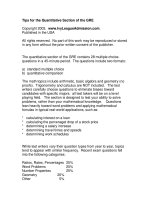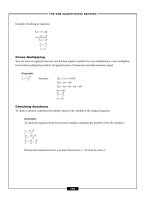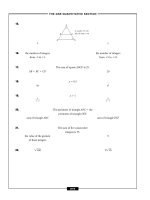The gre anlytycal writting section 6 ppsx
Bạn đang xem bản rút gọn của tài liệu. Xem và tải ngay bản đầy đủ của tài liệu tại đây (66.15 KB, 6 trang )
■
To simplify a square root radical, write the radicand as the product of two factors, with one number
being the largest perfect square factor. Then write the radical of each factor and simplify.
Example:
͙8
ෆ
= ͙4
ෆ
ϫ ͙2
ෆ
= 2͙2
ෆ
Ratio
The ratio of the numbers 10 to 30 can be expressed in several ways, for example:
10 to 30 or
10:30 or
ᎏ
1
3
0
0
ᎏ
Since a ratio is also an implied division, it can be reduced to lowest terms. Therefore, since both 10 and 30
are multiples of 10, the above ratio can be written as:
1 to 3 or
1:3 or
ᎏ
1
3
ᎏ
Algebra Review
Congratulations on completing the arithmetic section. Fortunately, you will only need to know a small por-
tion of algebra normally taught in a high school algebra course for the GRE. The following section outlines
only the essential concepts and skills you will need for success on the GRE Quantitative section.
Equations
An equation is solved by finding a number that is equal to a certain variable.
SIMPLE RULES FOR WORKING WITH EQUATIONS
1. The equal sign seperates an equation into two sides.
2. Whenever an operation is performed on one side, the same operation must be performed on the other side.
3. Your first goal is to get all the variables on one side and all the numbers on the other.
4. The final step often is to divide each side by the coefficient, leaving the variable equal to a number.
– THE GRE QUANTITATIVE SECTION–
165
Example of solving an equation:
3x + 5 = 20
–5 = –5
3x = 15
ᎏ
3
3
x
ᎏ
=
ᎏ
1
3
5
ᎏ
x = 5
Cross Multiplying
You can solve an equation that sets one fraction equal to another by cross multiplication. Cross multiplica-
tion involves setting the products of opposite pairs of numerators and denominators equal.
Example:
ᎏ
6
x
ᎏ
=
ᎏ
x +
12
10
ᎏ
becomes 12x = (x) + 6(10)
12x = 6x + 60
12x – 6x = 6x – 6x + 60
6x = 60
ᎏ
6
6
x
ᎏ
=
ᎏ
6
6
0
ᎏ
x = 10
Checking Solutions
To check a solution, substitute the number equal to the variable in the original equation.
Example:
To check the equation from the previous example, substitute the number 10 for the variable x.
ᎏ
6
x
ᎏ
=
ᎏ
x +
12
10
ᎏ
ᎏ
1
6
0
ᎏ
=
ᎏ
10
1
+
2
10
ᎏ
ᎏ
1
6
0
ᎏ
=
ᎏ
2
1
0
2
ᎏ
=
ᎏ
1
6
0
ᎏ
Because this statement is true, you know the answer x = 10 must be correct.
– THE GRE QUANTITATIVE SECTION–
166
Special Tips for Checking Solutions
1. If time permits, be sure to check all solutions.
2. If you get stuck on a problem with an equation, check each answer, beginning with choice c. If choice c
is not correct, pick an answer choice that is either larger or smaller. This process will be further
explained in the strategies for answering five-choice questions.
3. Be careful to answer the question that is being asked. Sometimes, this involves solving for a variable
and then performing another operation.
Example:
If the question asks the value of x – 2 and you find x = 2, the answer is not 2, but 2 – 2.
Thus, the answer is 0.
Equations with More than One Variable
Many equations have more than one variable. To find the solution, solve for one variable in terms of the
other(s). To do this, follow the rule regarding variables and numbers on opposite sides of the equal sign.
Isolate only one variable.
Example:
Solve for x.
2x + 4y = 12 To isolate the x variable, move the 4y to the other side.
–4y = –4y
2x = 12 – 4y Then divide both sides by the coefficient of 2.
ᎏ
2
2
x
ᎏ
=
ᎏ
12
2
–4y
ᎏ
Simplify your answer.
x = 6 – 2y This expression for x is written in terms of y.
Polynomials
A polynomial is the sum or difference of two or more unlike terms. Like terms have exactly the same variable(s).
Example:
2x + 3y – z
The above expression represents the sum of three unlike terms: 2x,3y, and –z.
Three Kinds of Polynomials
■
A monomial is a polynomial with one term, as in 2b
3
.
■
A binomial is a polynomial with two unlike terms, as in 5x + 3y.
■
A trinomial is a polynomial with three unlike terms, as in y
2
+ 2z – 6x.
– THE GRE QUANTITATIVE SECTION–
167
Operations with Polynomials
■
To add polynomials, be sure to change all subtraction to addition and change the sign of the number
being subtracted. Then simply combine like terms.
Example:
(3y
3
– 5y + 10) + (y
3
+ 10y – 9) Begin with a polynomial.
3y
3
+ –5y + 10 + y
3
+ 10y + –9 Change all subtraction to addition and
change the sign of the number being
subtracted.
3y
3
+ y
3
+ –5y + 10y + 10 + –9 = 4y
3
+ 5y + 1 Combine like terms.
■
If an entire polynomial is being subtracted, change all the subtraction to addition within the parenthe-
ses and then add the opposite of each term in the polynomial being subtracted.
Example:
(8x – 7y + 9z) – (15x + 10y – 8z) Begin with a polynomial.
(8x + –7y + 9z) + (–15x + –10y + –8z) Change all subtraction within the parameters first.
(8x + –7y + 9z) + (–15x + –10y + 8z) Then change the subtraction sign outside of the
parentheses to addition and the sign of each
polynomial being subtracted.
(Note that the sign of the term 8z changes twice
because it is being subtracted twice.)
8x + –15x + –7y + –10y + 9z + 8z Combime like terms.
–7x + –17y + 17z This is your answer
■
To multiply monomials, multiply their coefficients and multiply like variables by subtracting their
exponents.
Example:
(–5x
3
y)(2x
2
y
3
) = (–5)(2)(x
3
)(x
2
)(y)(y
3
) = –10
5
y
4
■
To divide monomials, divide their coefficients and divide like variables by subtracting their exponents.
Example:
ᎏ
1
2
6
4
x
x
4
3
y
y
5
2
ᎏ
=
ᎏ
(
(
1
2
6
4
)
)
ᎏ
ᎏ
(
(
x
x
3
)
)
ᎏ
ᎏ
(
(
y
y
5
2
)
)
ᎏ
=
ᎏ
2
3
ᎏ
xy
3
■
To multiply a polynomial by a monomial, multiply each term of the polynomial by the monomial and
add the products.
– THE GRE QUANTITATIVE SECTION–
168
Example:
6x(10x – 5y + 7)
Change subtraction to addition: 6x(10x + –5y + 7)
Multiply: (6x)(10x) + (6x)(–5y) + (6x)(7)
Your answer is: 60x
2
+ –30xy + 42x
■
To divide a polynomial by a monomial, divide each term of the polynomial by the monomial and add
the quotients.
Example:
=
ᎏ
5
5
x
ᎏ
–
ᎏ
1
5
0y
ᎏ
+
ᎏ
2
5
0
ᎏ
= x – 2y + 4
FOIL
The FOIL method is used when multiplying two binomials. FOIL stands for the order used to multiply the
terms: First, Outer, Inner, and Last. To multiply binomials, you multiply according to the FOIL order and then
add the products.
Example:
(3x + 1)(7x + 10) =
3x and 7x are the first pair of terms,
3x and 10 are the outermost pair of terms,
1 and 7x are the innermost pair of terms, and
1 and 10 are the last pair of terms.
Therefore, (3x)(7x) + (3x)(10) + (1)(7x) + (1)(10) = 21x
2
+ 30x + 7x + 10.
After combining like terms, the answer is: 21x
2
+ 37x +10.
Factoring
Factoring is the reverse of multiplication:
2(x + y) = 2x + 2y Multiplication
2x + 2y = 2(x + y) Factoring
Three Basic Types of Factoring
1. Factoring out a common monomial:
10x
2
– 5x = 5x(2x – 1) and xy – zy = y(x –z)
2. Factoring a quadratic trinomial using the reverse of FOIL:
y
2
– y – 12 = (y – 4)(y + 3) and z
2
– 2z + 1 = (z –1)(z – 1) = (z – 1)
2
3. Factoring the difference between two squares using the rule:
a
2
– b
2
= (a + b)(a – b) and x
2
– 25 = (x + 5)(x – 5)
5x – 10y + 20
ᎏᎏ
5
– THE GRE QUANTITATIVE SECTION–
169
Removing a Common Factor
If a polynomial contains terms that have common factors, you can factor the polynomial by using the reverse
of the distributive law.
Example:
In the binomial 49x
3
+ 21x,7x is the greatest common factor of both terms. Therefore, you can divide
49x
3
+ 21x by 7x to get the other factor.
ᎏ
49x
3
7
+
x
21x
ᎏ
=
ᎏ
49
7
x
x
3
ᎏ
+
ᎏ
2
7
1
x
x
ᎏ
= 7x
2
+ 3
Thus, factoring 49x
3
+ 21x results in 7x(7x
2
+ 3).
Isolating Variables Using Fractions
It may be necessary to use factoring to isolate a variable in an equation.
Example:
If ax – c = bx + d, what is x in terms of a, b, c, and d?
■
The first step is to get the “x” terms on the same side of the equation:
ax – bx = c + d
■
Now you can factor out the common “x” term on the left side:
x(a – b) = c + d
■
To finish, divide both sides by a – b to isolate x:
ᎏ
x(
a
a
–
–
b
b)
ᎏ
=
ᎏ
c
a
+
–b
d
ᎏ
■
The a – b binomial cancels out on the left, resulting in the answer:
x =
ᎏ
c
a
+
–b
d
ᎏ
Quadratic Trinomials
A quadratic trinomial contains an x
2
term as well as an x term; x
2
– 5x + 6 is an example of a quadratic
trinomial. Reverse the FOIL method to factor.
■
Start by looking at the last term in the trinomial, the number 6. Ask yourself,“What two integers, when
multiplied together, have a product of positive 6?”
■
Make a mental list of these integers:
1 ϫ 6, –1 ϫ –6, 2 ϫ 3, and –2 ϫ –3
■
Next, look at the middle term of the trinomial, in this case, the negative 5x. Choose the two factors
from the above list that also add up to negative 5. Those two factors are: –2 and –3.
■
Thus, the trinomial x
2
– 5x + 6 can be factored as (x – 3)(x – 2).
■
Be sure to use FOIL to double check your answer. The correct answer is:
(x – 3)(x – 2) = x
2
– 2x – 3x + 6 = x
2
– 5x + 6
– THE GRE QUANTITATIVE SECTION–
170









